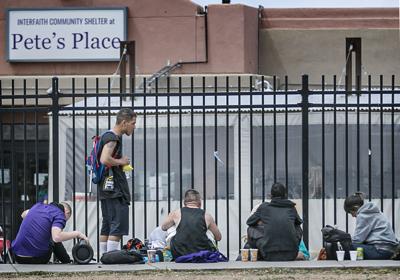The Interfaith Community Shelter at Pete’s Place has provided tens of thousands of meals and beds for over 100 people on cold winter nights since it opened in late 2009 in a former pet shop.
It has also served as a lightning rod for criticism from people living and working in the surrounding neighborhood.
A violent incident Wednesday afternoon that ended in a police shooting near the homeless shelter, at the intersection of Cerrillos and Harrison roads, was the latest in what residents and business owners say has been an escalation in crime and other problems in the area.
Santa Fe police officers shot a man they suspect of stealing a kitchen knife from nearby Café Castro and trying to carjack a family in the parking lot. Jermaine Garcia, who was wounded by gunshots and hospitalized, faces several charges, police say.
Garcia wasn’t a guest of the shelter, according to its top executive. But residents and workers in the area say much of the crime and other problems in the neighborhood surrounding Pete’s Place is carried out by people who gather outside near the shelter in growing numbers — not necessarily those who sleep there.
“Things are pretty bad,” said Klaus Herring, the owner of Rapid Restoration on Calle de Comercio.
Herring said he might move his business because of the increasing crime and drug use in the neighborhood. Some of his employees no longer drive down Harrison Road to get to work because they don’t feel safe, he added.
Amanda Tucker, who runs The Mystic, a restaurant and hotel across Cerrillos Road from the shelter, said homeless encampments, drug use and increasing crime are “not good for business.”
She and her husband, Rick Goldberg, are trying to “take a part of this city that people don’t normally visit and make it desirable,” Tucker said. “I can’t do that if the city won’t help protect my property and my guests.”
Tucker criticized the city’s administration, which she said places a higher priority on areas of Santa Fe that attract more tourism.
“The way I see it, they would never put this on the Plaza, they would never put this on Canyon Road, but they seem to think our part of town is disposable,” she said of the shelter.
Santa Fe Mayor Alan Webber said he was in back-to-back meetings for much of Thursday and was not able to comment. He also declined to comment Wednesday on the police shooting.
City Councilor Signe Lindell, who represents District 1, where Pete’s Place is located, said she had little information about the shooting but has heard numerous complaints from people in the area over the years.
“The situation is very frustrating,” she said, adding Santa Fe needs more help from the state to provide supportive services and mental health resources.
“The city is not in a position to provide all the help that’s needed, not just for that location but for all unsheltered people,” Lindell said.
Councilor Michael Garcia said he would like to see more data about what might be driving an increase in problems.
“The unfortunate incident yesterday will begin a conversation in regards to, is there another way we can support the unhoused in our community that doesn’t negatively impact surrounding areas?” he said.
Other councilors did not respond to inquiries, including Alma Castro, who runs Café Castro, her family’s business. The restaurant shut down Wednesday following the shooting.
Several business owners said they hoped Castro, elected to her council seat in November, would bring attention to the issue.
“I know that she’s just as concerned as everybody else,” Herring said.
Castro held a town hall in February for District 1 residents along the Cerrillos Road corridor, much of which centered on people’s frustrations with drug use and homelessness.
Jay Grady, the owner of Adobe Interlock at the intersection of Rufina Street and Calle de Comercio, said problems in the area around the shelter seemed to improve after Executive Director Korina Lopez stepped into the position 2021, but they are now as bad as ever.
“If we called the police every time we saw something, it would be 15 times a day,” he said.
How much of the trouble surrounding the shelter involves regular Pete’s Place guests is unclear.
Lopez said Jermaine Garcia, the man shot by police, has never spent a night in the shelter, according to its records, and he was banned from the property in 2019.
“Pete’s Place did not cause homelessness,” Lopez said. “We’re trying to address it by providing services to people who are unhoused.”
“The biggest issue with Pete’s is not the homeless, it’s the drugs,” Grady said, adding some of the people who have purchased his ignition interlock devices — alcohol breath tests that prevent a car from starting — have lived at Pete’s Place and turned their lives around.
Herring and Kat Albert, a filmmaker who lives and works in the area, agreed. Albert said she sees near-daily drug deals across the street from her home. Pete’s Place provides an important service, she said, but its positive effect is dampened by many of the people who congregate in the area around it.
Albert said, “We think [Pete’s Place’s] existence brings all these other elements into our neighborhood.”
Lopez acknowledged the shelter’s “low-barrier” status — meaning it does not turn away people who are intoxicated or high on drugs — draws a “mixed bag” of people, and that it serves many who struggle with drug addiction and mental illness, as well as lifelong trauma.
“Some things, like drug use and dealing are an unfortunate reality that comes with the territory of serving individuals who are unhoused due to severe mental illness or severe addiction issues,” she said.
But, she added, “that’s not going to stop me from providing someone a meal, a hot shower, clothes to wear, because at the end of the day, that’s a human being.”
The shelter’s staff and volunteers are aware of people congregating in the area, and its security guards turn people away when they loiter nearby if they are not receiving services there.
Sometimes, however, Lopez said, homeless people congregating is unavoidable.
“If you’re providing services to homeless individuals, of course there is going to be homeless people there,” she said.
Lopez said she isn’t opposed to moving the shelter to a different site in Santa Fe, but she noted its central location in a commercial district on a bus line makes it more accessible to a larger number of people.
“If people can’t access your services, then you’re serving no one,” she said.
Homelessness came up during a city Finance Committee budget hearing Thursday, when the Community Health and Safety Department presented its goals for the upcoming fiscal year.
The department previously was helmed by Kyra Ochoa, who was instrumental in many of the city’s efforts to address homelessness.
Following Ochoa’s departure in January, the department is being led by City Manager John Blair amid a search for a new director.
Webber praised the department’s work to address the homeless crisis. The issue is much bigger than Santa Fe, he noted.
“There’s not a city in the U.S. that isn’t wrestling with the intersection of homelessness coupled sometimes with opioid addiction or fentanyl use,” he said.









